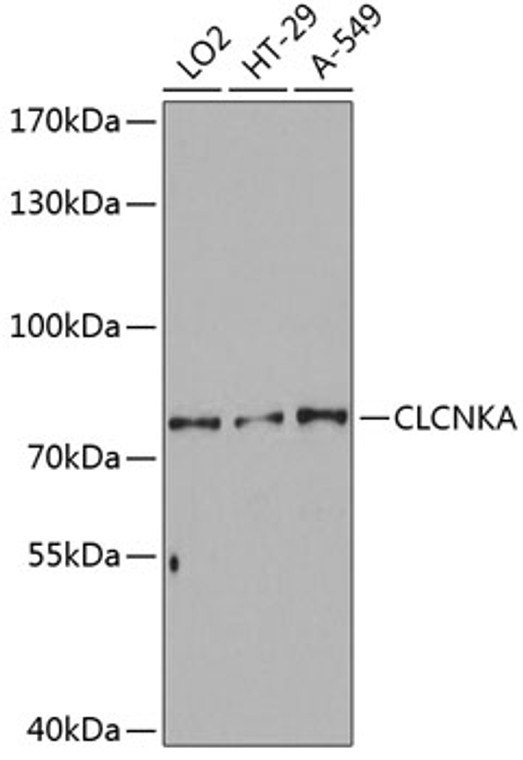| Host: |
Rabbit |
| Applications: |
WB/ELISA |
| Reactivity: |
Human/Mouse |
| Note: |
STRICTLY FOR FURTHER SCIENTIFIC RESEARCH USE ONLY (RUO). MUST NOT TO BE USED IN DIAGNOSTIC OR THERAPEUTIC APPLICATIONS. |
| Clonality: |
Polyclonal |
| Conjugation: |
Unconjugated |
| Isotype: |
IgG |
| Formulation: |
PBS with 0.01% Thimerosal, 50% Glycerol, pH 7.3. |
| Purification: |
Affinity purification |
| Concentration: |
Lot specific |
| Dilution Range: |
WB:1:500-1:2000ELISA:Recommended starting concentration is 1 Mu g/mL. Please optimize the concentration based on your specific assay requirements. |
| Storage Instruction: |
Store at-20°C for up to 1 year from the date of receipt, and avoid repeat freeze-thaw cycles. |
| Gene Symbol: |
CLCNKA |
| Gene ID: |
1187 |
| Uniprot ID: |
CLCKA_HUMAN |
| Immunogen Region: |
470-644 |
| Specificity: |
Recombinant fusion protein containing a sequence corresponding to amino acids 470-644 of human CLCNKA (NP_001244068.1). |
| Immunogen Sequence: |
QSCQPSFYDGTIIVKKLPYL PRILGRNIGSHHVRVEHFMN HSITTLAKDTPLEEVVKVVT STDVTEYPLVESTESQILVG IVQRAQLVQALQAEPPSRAP GHQQCLQDILARGCPTEPVT LTLFSETTLHQAQNLFKLLN LQSLFVTSRGRAVGCVSWVE MKKAISNLTNPPAPK |
| Function | Anion-selective channel permeable to small monovalent anions with ion selectivity for chloride > bromide > nitrate > iodide. Forms a homodimeric channel where each subunit has its own ion conduction pathway. May conduct double-barreled currents controlled by two types of gates, two fast gates that control each subunit independently and a slow common gate that opens and shuts off both subunits simultaneously. Assembles with the regulatory subunit BSND/Barttin for sorting at the basolateral plasma membrane domain and functional switch to the ion conducting state. CLCNKA:BSND channels display mostly a linear current-voltage relationship with fast gating at negative potentials. Mediates transepithelial chloride transport from the lumen to interstitial compartment along the thin ascending limb of Henle's loop, contributing to generation of hypertonic medullary interstitium as a countercurrent system to achieve urine concentration. Conducts chloride currents in the stria vascularis of the inner ear to establish the endocochlear potential necessary for normal hearing. |
| Protein Name | Chloride Channel Protein Clc-KaChloride Channel KaClc-K1 |
| Database Links | Reactome: R-HSA-2672351 |
| Cellular Localisation | Basolateral Cell MembraneMulti-Pass Membrane Protein |
| Alternative Antibody Names | Anti-Chloride Channel Protein Clc-Ka antibodyAnti-Chloride Channel Ka antibodyAnti-Clc-K1 antibodyAnti-CLCNKA antibody |
Information sourced from Uniprot.org
12 months for antibodies. 6 months for ELISA Kits. Please see website T&Cs for further guidance





![Western blot analysis of lysates from wild type (WT) and TTLL12 knockout (KO) 293T cells, using [KO Validated] TTLL12 Rabbit polyclonal antibody (STJ11100870) at 1:1000 dilution. Secondary antibody: HRP Goat Anti-Rabbit IgG (H+L) (STJS000856) at 1:10000 dilution. Lysates/proteins: 25 Mu g per lane. Blocking buffer: 3% nonfat dry milk in TBST. Detection: ECL Basic Kit. Exposure time: 1s. Western blot analysis of lysates from wild type (WT) and TTLL12 knockout (KO) 293T cells, using [KO Validated] TTLL12 Rabbit polyclonal antibody (STJ11100870) at 1:1000 dilution. Secondary antibody: HRP Goat Anti-Rabbit IgG (H+L) (STJS000856) at 1:10000 dilution. Lysates/proteins: 25 Mu g per lane. Blocking buffer: 3% nonfat dry milk in TBST. Detection: ECL Basic Kit. Exposure time: 1s.](https://cdn11.bigcommerce.com/s-zso2xnchw9/images/stencil/300x300/products/89804/358271/STJ11100870_1__29815.1713122614.jpg?c=1)

